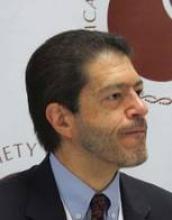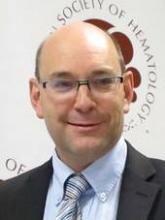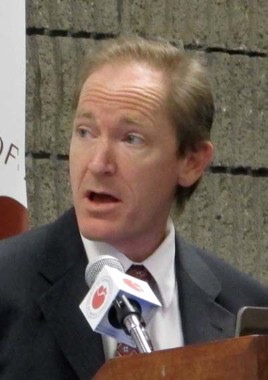User login
ATLANTA – The experimental drug quizartinib bought significant time for some patients with acute myeloid leukemia bearing a high-risk FLT3-ITD mutation, investigators reported at the annual meeting of the American Society of Hematology.
Among patients positive for FLT3-ITD, the composite complete remission rate (CRc) was 46%, and 27% of patients had a partial response. Both rates were higher than in patients without the mutation, of whom 32% had a CRc, and 16% a partial response.
The median duration of the remissions was 12.1 weeks for FLT3-ITD–positive patients, and 7.0 weeks for those lacking the mutation, reported Dr. Mark J. Levis of the Sidney Kimmel Comprehensive Cancer Center at Johns Hopkins University in Baltimore.
Although median overall survival was not significantly different among all patients in the open-label trial, it improved significantly among FLT3-ITD–positive patients for whom quizartinib served as bridge to hematopoietic stem cell transplant (HSCT). Median survival in FLT3-ITD–positive patients who received a transplant was 33.3 weeks, compared with 17.7 weeks for those not transplanted.
"Our focus for this drug is to clear the leukemia out of the patient's bone marrow to a sufficient degree to allow them to go for a bone marrow transplant," said Dr. Levis at a press briefing. More than a third of patients were bridged to transplant, with 18 long-term survivors, he said.
In a separate presentation looking at a separate cohort of patients aged 60 years and older, another high-risk population in the study, Dr. Jorge Cortes of the University of Texas M.D. Anderson Cancer Center in Houston reported a 54% CRc rate, with 13% of patients surviving more than 1 year and 8% still alive at last follow-up.
Patients tolerated the drug, a tyrosine kinase inhibitor (TKI), very well, and had toxicities that could generally be managed well, Dr. Cortes and Dr. Levis said in their presentations.
New Era Foreseen in Relapsed /Refractory AML
A leukemia specialist who was not involved in the trial said that quizartinib, which is specifically targeted against FLT3, may be ushering in a new era of treatment options for patients with relapsed or refractory AML.
"We see these patients, they come to us having relapsed after standard therapy, they have this mutation, and there’s nothing we can offer that’s standard therapy – their survival is measured in weeks," said Dr. Aaron Schimmer of the Princess Margaret Cancer Centre of the University Health Network in Toronto.
"Now, they can receive a targeted agent that is exceptionally well tolerated and in large number of patients is producing responses that allow them to on to potentially curative bone marrow transplant," he said.
Dr. Schimmer moderated a press briefing at which Dr. Levis presented data on one of the study cohorts.
Tenfold Higher Potency Than Other Agents
FLT3 has been an attractive target for drug developers because it is expressed in hematopoietic progenitor cells and its signals promote proliferation and differentiation of cells. It is found to be overexpressed in the majority of AML cases, and the FLT3-ITD mutation is found in up to one-third of patients with AML, Dr. Levis said.
Quizartinib is the latest in a line of agents aimed squarely at FLT3, with the ability to selective inhibit FLT3 while avoiding other targets at much smaller concentrations than that required for agents such lestaurtinib, midostaurin, and sorafenib (Nexavar) – giving the drug about a 10-fold higher potency than the other agents, Dr. Levis said.
In the phase II AC220-002 trial, investigators enrolled 271 patients with primary AML or AML secondary to the myelodysplastic syndrome.
One cohort enrolled 133 patients aged 60 years and older who had had their first relapse within the previous year or were refractory to first-line therapy. In this cohort, 90 patients were FLT3-ITD positive.
The other cohort included 138 patients 18 and older (100 FLT3-ITD–positive) who had relapsed after or were refractory to second-line treatment or HSCT.
In the older-patient cohort described by Dr. Cortes, the CRc rate (a composite of complete remissions plus complete remissions with incomplete platelet and/or hematologic recovery) in FLT3-ITD–positive patients was 50%, and the partial response rate was 21%. Among FLT3-ITD–negative patients, the CRc rate was 36%, and the PR rate was 10%.
In these patients, 70% of those carrying the mutation and 55% of those without the mutation who had been refractory to their last prior therapy achieved at least a partial response. The median duration of remission was 10.4 weeks for FLT3-ITD–positive patients, and 9.3 weeks for –negative patients.
Patients tolerated the drug very well, with the most serious event being a reversible prolongation of the QT interval, and dose-limiting myelosuppression, possibly related to inhibition of the KIT kinase, said Dr. Levis.
The study was funded by Ambit Biosciences, maker of quizartinib (AC220). Dr. Levis disclosed serving as a consultant to the company. Dr. Cortes disclosed serving as a consultant to Novartis.
ATLANTA – The experimental drug quizartinib bought significant time for some patients with acute myeloid leukemia bearing a high-risk FLT3-ITD mutation, investigators reported at the annual meeting of the American Society of Hematology.
Among patients positive for FLT3-ITD, the composite complete remission rate (CRc) was 46%, and 27% of patients had a partial response. Both rates were higher than in patients without the mutation, of whom 32% had a CRc, and 16% a partial response.
The median duration of the remissions was 12.1 weeks for FLT3-ITD–positive patients, and 7.0 weeks for those lacking the mutation, reported Dr. Mark J. Levis of the Sidney Kimmel Comprehensive Cancer Center at Johns Hopkins University in Baltimore.
Although median overall survival was not significantly different among all patients in the open-label trial, it improved significantly among FLT3-ITD–positive patients for whom quizartinib served as bridge to hematopoietic stem cell transplant (HSCT). Median survival in FLT3-ITD–positive patients who received a transplant was 33.3 weeks, compared with 17.7 weeks for those not transplanted.
"Our focus for this drug is to clear the leukemia out of the patient's bone marrow to a sufficient degree to allow them to go for a bone marrow transplant," said Dr. Levis at a press briefing. More than a third of patients were bridged to transplant, with 18 long-term survivors, he said.
In a separate presentation looking at a separate cohort of patients aged 60 years and older, another high-risk population in the study, Dr. Jorge Cortes of the University of Texas M.D. Anderson Cancer Center in Houston reported a 54% CRc rate, with 13% of patients surviving more than 1 year and 8% still alive at last follow-up.
Patients tolerated the drug, a tyrosine kinase inhibitor (TKI), very well, and had toxicities that could generally be managed well, Dr. Cortes and Dr. Levis said in their presentations.
New Era Foreseen in Relapsed /Refractory AML
A leukemia specialist who was not involved in the trial said that quizartinib, which is specifically targeted against FLT3, may be ushering in a new era of treatment options for patients with relapsed or refractory AML.
"We see these patients, they come to us having relapsed after standard therapy, they have this mutation, and there’s nothing we can offer that’s standard therapy – their survival is measured in weeks," said Dr. Aaron Schimmer of the Princess Margaret Cancer Centre of the University Health Network in Toronto.
"Now, they can receive a targeted agent that is exceptionally well tolerated and in large number of patients is producing responses that allow them to on to potentially curative bone marrow transplant," he said.
Dr. Schimmer moderated a press briefing at which Dr. Levis presented data on one of the study cohorts.
Tenfold Higher Potency Than Other Agents
FLT3 has been an attractive target for drug developers because it is expressed in hematopoietic progenitor cells and its signals promote proliferation and differentiation of cells. It is found to be overexpressed in the majority of AML cases, and the FLT3-ITD mutation is found in up to one-third of patients with AML, Dr. Levis said.
Quizartinib is the latest in a line of agents aimed squarely at FLT3, with the ability to selective inhibit FLT3 while avoiding other targets at much smaller concentrations than that required for agents such lestaurtinib, midostaurin, and sorafenib (Nexavar) – giving the drug about a 10-fold higher potency than the other agents, Dr. Levis said.
In the phase II AC220-002 trial, investigators enrolled 271 patients with primary AML or AML secondary to the myelodysplastic syndrome.
One cohort enrolled 133 patients aged 60 years and older who had had their first relapse within the previous year or were refractory to first-line therapy. In this cohort, 90 patients were FLT3-ITD positive.
The other cohort included 138 patients 18 and older (100 FLT3-ITD–positive) who had relapsed after or were refractory to second-line treatment or HSCT.
In the older-patient cohort described by Dr. Cortes, the CRc rate (a composite of complete remissions plus complete remissions with incomplete platelet and/or hematologic recovery) in FLT3-ITD–positive patients was 50%, and the partial response rate was 21%. Among FLT3-ITD–negative patients, the CRc rate was 36%, and the PR rate was 10%.
In these patients, 70% of those carrying the mutation and 55% of those without the mutation who had been refractory to their last prior therapy achieved at least a partial response. The median duration of remission was 10.4 weeks for FLT3-ITD–positive patients, and 9.3 weeks for –negative patients.
Patients tolerated the drug very well, with the most serious event being a reversible prolongation of the QT interval, and dose-limiting myelosuppression, possibly related to inhibition of the KIT kinase, said Dr. Levis.
The study was funded by Ambit Biosciences, maker of quizartinib (AC220). Dr. Levis disclosed serving as a consultant to the company. Dr. Cortes disclosed serving as a consultant to Novartis.
ATLANTA – The experimental drug quizartinib bought significant time for some patients with acute myeloid leukemia bearing a high-risk FLT3-ITD mutation, investigators reported at the annual meeting of the American Society of Hematology.
Among patients positive for FLT3-ITD, the composite complete remission rate (CRc) was 46%, and 27% of patients had a partial response. Both rates were higher than in patients without the mutation, of whom 32% had a CRc, and 16% a partial response.
The median duration of the remissions was 12.1 weeks for FLT3-ITD–positive patients, and 7.0 weeks for those lacking the mutation, reported Dr. Mark J. Levis of the Sidney Kimmel Comprehensive Cancer Center at Johns Hopkins University in Baltimore.
Although median overall survival was not significantly different among all patients in the open-label trial, it improved significantly among FLT3-ITD–positive patients for whom quizartinib served as bridge to hematopoietic stem cell transplant (HSCT). Median survival in FLT3-ITD–positive patients who received a transplant was 33.3 weeks, compared with 17.7 weeks for those not transplanted.
"Our focus for this drug is to clear the leukemia out of the patient's bone marrow to a sufficient degree to allow them to go for a bone marrow transplant," said Dr. Levis at a press briefing. More than a third of patients were bridged to transplant, with 18 long-term survivors, he said.
In a separate presentation looking at a separate cohort of patients aged 60 years and older, another high-risk population in the study, Dr. Jorge Cortes of the University of Texas M.D. Anderson Cancer Center in Houston reported a 54% CRc rate, with 13% of patients surviving more than 1 year and 8% still alive at last follow-up.
Patients tolerated the drug, a tyrosine kinase inhibitor (TKI), very well, and had toxicities that could generally be managed well, Dr. Cortes and Dr. Levis said in their presentations.
New Era Foreseen in Relapsed /Refractory AML
A leukemia specialist who was not involved in the trial said that quizartinib, which is specifically targeted against FLT3, may be ushering in a new era of treatment options for patients with relapsed or refractory AML.
"We see these patients, they come to us having relapsed after standard therapy, they have this mutation, and there’s nothing we can offer that’s standard therapy – their survival is measured in weeks," said Dr. Aaron Schimmer of the Princess Margaret Cancer Centre of the University Health Network in Toronto.
"Now, they can receive a targeted agent that is exceptionally well tolerated and in large number of patients is producing responses that allow them to on to potentially curative bone marrow transplant," he said.
Dr. Schimmer moderated a press briefing at which Dr. Levis presented data on one of the study cohorts.
Tenfold Higher Potency Than Other Agents
FLT3 has been an attractive target for drug developers because it is expressed in hematopoietic progenitor cells and its signals promote proliferation and differentiation of cells. It is found to be overexpressed in the majority of AML cases, and the FLT3-ITD mutation is found in up to one-third of patients with AML, Dr. Levis said.
Quizartinib is the latest in a line of agents aimed squarely at FLT3, with the ability to selective inhibit FLT3 while avoiding other targets at much smaller concentrations than that required for agents such lestaurtinib, midostaurin, and sorafenib (Nexavar) – giving the drug about a 10-fold higher potency than the other agents, Dr. Levis said.
In the phase II AC220-002 trial, investigators enrolled 271 patients with primary AML or AML secondary to the myelodysplastic syndrome.
One cohort enrolled 133 patients aged 60 years and older who had had their first relapse within the previous year or were refractory to first-line therapy. In this cohort, 90 patients were FLT3-ITD positive.
The other cohort included 138 patients 18 and older (100 FLT3-ITD–positive) who had relapsed after or were refractory to second-line treatment or HSCT.
In the older-patient cohort described by Dr. Cortes, the CRc rate (a composite of complete remissions plus complete remissions with incomplete platelet and/or hematologic recovery) in FLT3-ITD–positive patients was 50%, and the partial response rate was 21%. Among FLT3-ITD–negative patients, the CRc rate was 36%, and the PR rate was 10%.
In these patients, 70% of those carrying the mutation and 55% of those without the mutation who had been refractory to their last prior therapy achieved at least a partial response. The median duration of remission was 10.4 weeks for FLT3-ITD–positive patients, and 9.3 weeks for –negative patients.
Patients tolerated the drug very well, with the most serious event being a reversible prolongation of the QT interval, and dose-limiting myelosuppression, possibly related to inhibition of the KIT kinase, said Dr. Levis.
The study was funded by Ambit Biosciences, maker of quizartinib (AC220). Dr. Levis disclosed serving as a consultant to the company. Dr. Cortes disclosed serving as a consultant to Novartis.
AT THE ANNUAL MEETING OF THE AMERICAN SOCIETY OF HEMATOLOGY
Major Finding: Median overall survival in patients who were positive for the FLT3-ITD mutation and received a transplant was 33.3 weeks, vs. 17.7 weeks for those not transplanted.
Data Source: This was an open label efficacy study.
Disclosures: The study was funded by Ambit Biosciences, maker of quizartinib (AC220). Dr. Levis disclosed serving as a consultant to the company. Dr. Cortes disclosed serving as a consultant to Novartis.



